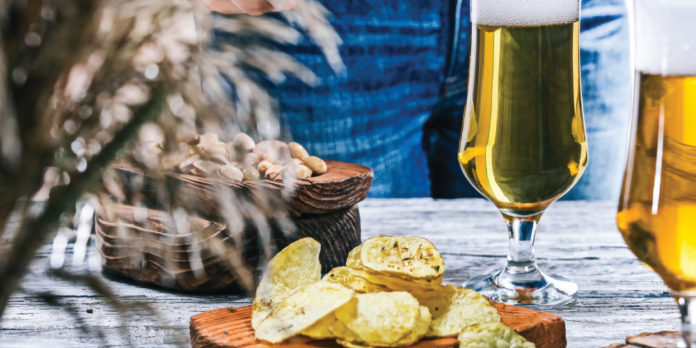Crisps & snacks is an important category. Joseph Lee looks at how suppliers are adapting to market trends and how wholesalers can stock the right products when there are so many to choose from.
Snacking is big business, being worth more than £2.8bn a year in the UK. With 82% of shoppers buying crisps and snacks on impulse, it’s crucial to the convenience channel.
By 2021, crisps & snacks sales will grow by 11.7% among convenience retailers, KP Snacks reports. The market is changing, though. Single-serve packs remain the largest part of crisps & snacks, but sales of this product are down by 8.5%.
Industry experts say that the new market for snacks is being driven by trends such as the growth of on-the-go snacking opportunities, shopper demand for value, the rise of health concerns and the increasing popularity of baked rather than fried snacks.
All systems on-the-go
Despite its recent fall, one reason why the single-serve pack isn’t likely to be completely dislodged from the top spot in snacking is down to the importance of on-the-go purchases.
“With increasingly frequent and smaller eating occasions, on-the-go is a major driver of growth in the snacks category,” says Hena Chandarana, trade communications controller at Pladis, the makers of Jacob’s crackers and McVitie’s biscuits.
On-the-go snacks account for more than half the growing category of food-to-go sales. In 2015, just 30% of customers bought on-the-go snacks; Pladis says the number last month was 40%.
That’s why the company is moving its biscuit range into snacking formats. Currently, only 7% of biscuits are available in on-the-go formats, but last year, McVitie’s launched portable twin-packs of some of its bestsellers.
There’s evidence that consumers are looking for more premium offerings when they’re on the move: 17.5% of snacks bought outside the home are purchased for a treat, for example.
That might explain why gourmet brands such as Kettle Chips have seen an annual increase of 6.8% for single-serve packs against the overall decline for the category.
The growth of ‘posh’ snacks is supported by a shift in the age of consumers.
According to Kevin Butterworth, marketing and international sales director at Seabrook Crisps, the fastest-growing category of snackers are the over-45s: “Adult snacking occasions, such as snacking alone, as a couple and within a group, are currently driving consumption of the total crisps and snacks category, as people are more likely to snack as they get older,” he says.
KP Snacks, whose McCoy’s grab bags sales are growing by 11.8%, argues that smarter merchandising can help shore up the single-serve market: “We have developed a tried and tested plan, which first and foremost focuses on the importance of core range,” Matt Collins, the company’s trading controller for convenience and wholesale, says. “The category is highly proliferated, with lots of products, formats and variants, and for a retailer or caterer, this can be confusing.”
“In line with the industry move to reduce case sizes over the past few years, we have been proactively changing our cases to smaller formats to facilitate cheaper wholesale prices, save space in-store and offer fresher products.”
Pierre Jackson, category insights controller at PepsiCo, emphasises the importance of focusing on bestselling brands in the single-serve market.
He says that there are more than 800 lines available to wholesalers in crisps alone, but in the average depot, the top 10 lines account for more than 20% of sales, while the bottom 100 contribute less than 1%.
The company’s brands, including Walkers, occupy 15 of the top 20 spots for bestselling single-serve products.
“An independent store sells on average 273 packs of savoury snacks every week, but it’s important for retailers to stock the right range, as a slower-selling line can take up to seven times longer to sell through than a fast-selling core range line,” he says. “Wholesalers can help retailers make informed decisions through the deployment of signage and merchandising to highlight the bestsellers.”
Good value is key to customer loyalty
“Most convenience shoppers cite price as a determining factor in purchases,” says Pladis’ Chandarana. “Transparent pricing and clear value for money is still of utmost importance to consumers.”
That makes sense for an impulse-driven category: it’s easier to get a spur-of-the-moment sale when the price seems irresistible.
Manufacturers are responding by increasing the supply of pricemarked packs (PMPs): “We are increasingly finding PMPs to be a key feature among independent retailers as a means of building trust with their shoppers as they communicate transparency on pricing,” Chandarana says. She adds that wholesalers should make prices easy to see, using PMP ranges wherever possible, and that the trade needs to maximise impulse sales and events by making promotions visible across the depot.
The company’s £1 sharing bag of Jacob’s Mini Cheddars is among its biggest sellers – and the growth of sharing bags is a trend identified by many suppliers.
PepsiCo’s Jackson says that sharing bag sales have grown by 9.4% over the past year and now make up nearly a quarter of all crisps sales. Over the course of a year, 86% of households will buy sharing bags at least once a month, the company says.
It’s a similar story at KP Snacks, where the Hula Hoops Big Hoops BBQ Beef £1 PMP is the second fastest-selling pack in convenience and growing at 9.5% a year.
Its £1 KP Nuts PMP is growing at 20.2% a year. “We are working with wholesalers on the right range to stock, focusing on value creation by offering PMPs with very competitive shared margins,” says KP’s Collins.
He adds: “Placing crisps and snacks on promotion has become a strong driver of incremental spend, with 31% of shoppers purchasing items on a deal as opposed to just 18% when they’re not on offer.”
Collins says that wholesalers can encourage retailers to build their range around these fast-selling, value-for-money products by arranging the flow of products in-depot by price. He suggests placing the popular £1 PMPs at the end to drive footfall down the aisle and increase impulse spending.
Collins also suggests using price-cut promotions on new products to drive retailers to try them, as well as using selective promotions on fast-moving low-cost products such as £1 PMP and 20p or 39p value packs.
Health is rising up the agenda
While many customers are looking for an indulgent treat, there’s plenty of evidence that messages concerning diet and health are affecting customers’ snacking habits.
PepsiCo has found that its Better For You single-serve packs have continued to grow by 5.3% a year, despite the overall decline in single-serve sales.
Other snacks perceived as healthier have also received a sales boost, with popcorn growing by 10.9% a year, according to Kettle Chips, which makes the Metcalfe’s Skinny Popcorn range.
The company is trying to stay ahead of health trends by reducing sugar in its sweet varieties of popcorn, with the Cinema Sweet range now using a sweetening blend including stevia leaf to reduce sugar by two-thirds, for a total of just 93 calories per 70g pack.
Stocking products such as these can have advantages for both retail and foodservice customers, according to Propercorn. The company says that half of all consumers believe retailers have a role to play in helping them make healthier decisions when feeding their family by stocking healthy products. And a quarter say they are put off from buying food and drink when they’re out at leisure venues because of a lack of healthy options.
Concerns about the effects of eating too much sugar or processed carbohydrates is sending some consumers to search for protein-based snacks: “Consumers are becoming more mindful of the quality of calories, which means that protein rich on-the-go products have become increasingly popular with shoppers,” says Judit Palfi, brand manager of Cathedral City Snacking.
The company is seizing on the opportunity to create a market for pre-packaged cheese snacks for adults, with most products currently focused on children. With 44% of adults saying they snacked on cheese in the past year, Cathedral City believes there’s a major opportunity.
So far, its Cathedral City snacking range has proved the point, with more than 9% growth by volume in the last year.
But healthy snacking isn’t just about calories. Consumers are increasingly concerned about other potential health effects, with many searching for ‘free-from’ products, such as those without gluten.
“A key trend to look out for is the rise in popularity of going gluten-free, as consumers are becoming increasingly health-conscious,” says Kevin Butterworth at Seabrook Crisps, which is accredited by Coeliac UK for being gluten-free. “As a result, gluten-free products have a wider appeal beyond consumers with coeliac disease.”
All about that baked
The drive for healthier products from consumers has led industry leaders to put more focus than ever on baked snacks. For Pladis, a company with a 100% baked range of snacks, that’s an opportunity: “There is increasing pressure on fried snacks, as a continuing focus on healthier, more balanced snacking, remains top of consumers’ minds when selecting products from the shelves,” says Chandarana. “As a result of this trend, baked snacks have played an increasingly larger role in driving growth back into the savoury category.”
Snackable crackers are proving to be one area of growth in the baked area for Pladis. Launched in 2015, Jacob’s Cracker Crisps have grown to boast a value of £14m, with a 33% increase year on year.
The company has seized on this growth and a high repeat purchase rate of 38% by investing £4.4m in marketing over the past year. It now has plans for a range of limited edition flavours.
Susan Nash, trade communications manager at Mondelez International, echoes Chandarana’s view. She says: “An increased awareness of healthier eating is having a major impact in savoury snacks, as consumers look for more permissible options that provide a greater choice.
“The trend is driving a shift away from snacks such as crisps – which may be considered unhealthy – and a growing appetite for products which are baked, not fried. As a result, the crisps category is currently seeing a decline of 6% in value sales, while savoury snacks are growing at 13.9%.”
Mondelez launched its Ritz Crisp & Thin product to answer this consumer demand. The product is available in 30g packs in three flavours: Cream Cheese & Onion; Sea Salt & Vinegar and Sweet Red Chilli.
PepsiCo is emphasising the taste of its baked range by launching new flavours. There’s a new Roast Chicken & Thyme flavour in the multipack range, while the company’s Crispy Crackers range is gaining an Italian Herb flavour.
Meanwhile, the Walkers Sensations range is gaining new exotic flavours, with Japanese Sweet Wasabi & Ginger and Chargrilled Steak & Chimichurri flavour crisps, alongside Mango & Red Chilli Chutney flavour poppadoms.
In addition, PepsiCo is using flavour in promotions as well as in new releases. Its current campaign offers the opportunity to boost sales of single-serve packs with the introduction of new flavours and – more controversially – the possibility that some old favourites might be phased out.
Called ‘choose me or lose me’, the campaign pits traditional favourites in the UK such as Salt & Vinegar, Prawn Cocktail and Smoky Bacon in duels against flavours drawn from the company’s international portfolio: Lime & Black Pepper, Paprika, and Bacon & Cheddar. In each head-to-head contest, the flavour with the most sales of single-serve packs (plus a 20% contribution from an online poll) will continue on sale, while the loser is allegedly going to be discontinued.
It’s a clever way to revive interest in the single-serve pack. Ensuring that you have adequate stock for the duration of the promotion is essential if you want to maximise your profit from this category.








